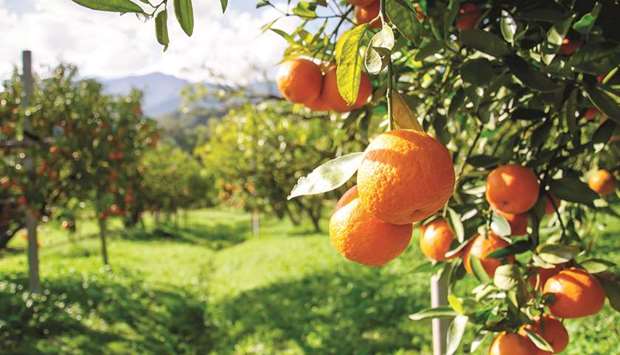A joy of winter is that supermarket produce sections come alive with a wide range of oranges, varieties that stretch beyond familiar Valencias.
Think of blood oranges, with their showy red-orange flesh. Or pink-tinted Cara Caras. Or small, juicy mandarins.
“When it’s cold outside, we have something nice and bright to look forward to,” said Lindsey Wolterstorff, produce manager of Valley Natural Foods in Burnsville, Minn. “We start to see stuff ramping up in December, and by January we’re in the heart of citrus season. It’ll wane out as spring comes in, when lots of little green vegetables can start to grow.”
The appearance of navel oranges (so named because the seedless variety, an ideal eating orange, sports a belly button-like knob) generally heralds the season’s arrival.
“Then it’s satsumas, and then clementines bring on another wave of excitement,” said Alex Christensen, assistant produce manager of the Seward Co-op’s Franklin Avenue store in Minneapolis. “Once the blood oranges hit, people are all-citrus, all the time. And that’s great, because it’s the time to do it.”
Kevin Hannigan, co-owner of the Produce Exchange in the Midtown Global Market in Minneapolis, said that year-round availability can make oranges commonplace.
“But when you get great oranges in season, they’re like great peaches at the peak of ripeness. People get excited about them, and we work hard to get the best.”
WHAT THE PROS BUY
Wolterstorff gravitates toward the Cara Cara.
“It’s everything you get in a navel, but they have an herbal, floral quality, and a much more complex flavor,” she said.
“They’re orange on the outside, and a beautiful pink on the inside. They’ve got the look of grapefruit without the sour and bitter qualities that some people don’t like.”
Samuel Philpot is one of two produce buyers at Eastside Food Co-op in Minneapolis. He looks forward to the midseason arrival of the TDE mandarin. “They’re a relatively new variety, a mix of Temple, Dancy and Encore mandarins,” he said “They’re my favorite, by far. The first season that they came in, I was blown away. They have a really nice, tangy profile. They’re not just about sweetness they have a well-rounded flavor.”
For Christensen, it’s all about the minneola tangelo, the fist-sized, bell-shaped cross between a tangerine and a grapefruit. “They’re the juiciest citrus that we see all season,” he said. “They start out a little watery, but the flavor gets richer and richer as they go on, and they end really well.”
Hannigan’s tastes are more universal. “I love it when we get great navel oranges, and I’m a big fan of sweet-tart citrus, so I love the clementines and the minneolas,” he said. “It sounds silly, but I love them all.”
COOKING WITH ORANGES
Oranges are berries, the fruit of subtropical evergreen trees. The majority of cultivated oranges end up in juice.
If you rely on oranges just for their juice, consider dropping temporarily, anyway - the ubiquitous Valencia, and replacing (or at least supplementing) it with a blood orange, a Cara Cara or another more colourful and flavourful seasonal fruit.
“The Valencia is the best juicing orange, it’s always going to give the greatest bang for your buck,” said Wolterstorff. “But you can use - or at least add in hints of other types of oranges to give juices so much more complexity.”
But with oranges, there’s more than juice.
Because eating oranges is physically restorative: An average-size orange contains 100 percent of the recommended daily intake of vitamin C, and also boasts vitamin A, potassium and dietary fiber. And their bright, refreshing bite is as spiritually energising as a burst of sunlight on an overcast January day.
“In general, my personal suggestion is that, if you want to eat more citrus, then literally, eat more citrus,” said Christensen. “Recognize that there are different flavors. That’s the joy of produce. Just eat it fresh, and whole. That’s the healthiest way to appreciate the flavor, directly.”
That said, oranges brighten just about any dish they touch. Acidic oranges make great stand-ins for similarly acidic tomatoes, and they’re delicious with avocados and olives.
Wolterstorff likes to pair oranges with vanilla yogurt.
“I’m also a huge sweet/savory person,” she said. “I just made a pork roast, and I sliced up onions and Cara Caras and cooked the pork on top of that, and it created a delicious pan sauce.”
Hannigan pointed to the growth of fresh citrus zest in cocktails and mocktails. “Or just adding zest to water,” he said. “People are looking to eliminate sugar and give more choices to their kids.”
Philpot likes to make candied citrus rind, simmering orange peels in a simple syrup made of water and sugar. “It’s easy,” he said. “You take them out of the syrup, and when they dry they get crispy and light. It’s a nice way to make candy, or a pastry garnish.”
Oranges can be stored on the counter for a few days. Just don’t place them in a bowl with apples or bananas, since both emit ethylene gas, which accelerates the ripening process.
In terms of longevity, oranges will thrive in the refrigerator. Be sure to keep them out of plastic bags, which will draw moisture from the fruit and hasten their spoilage.
Remember: The dead of winter is the time for maximum orange enjoyment.
“By comparison to other years, this is a very good year for oranges,” said Hannigan. “California had a hot growing summer, and then it got cold, and that helps the oranges. They’re picking up steam, and they’re getting really, really good.” - Star Tribune (Minneapolis)/ Los Angeles Times

Orange


